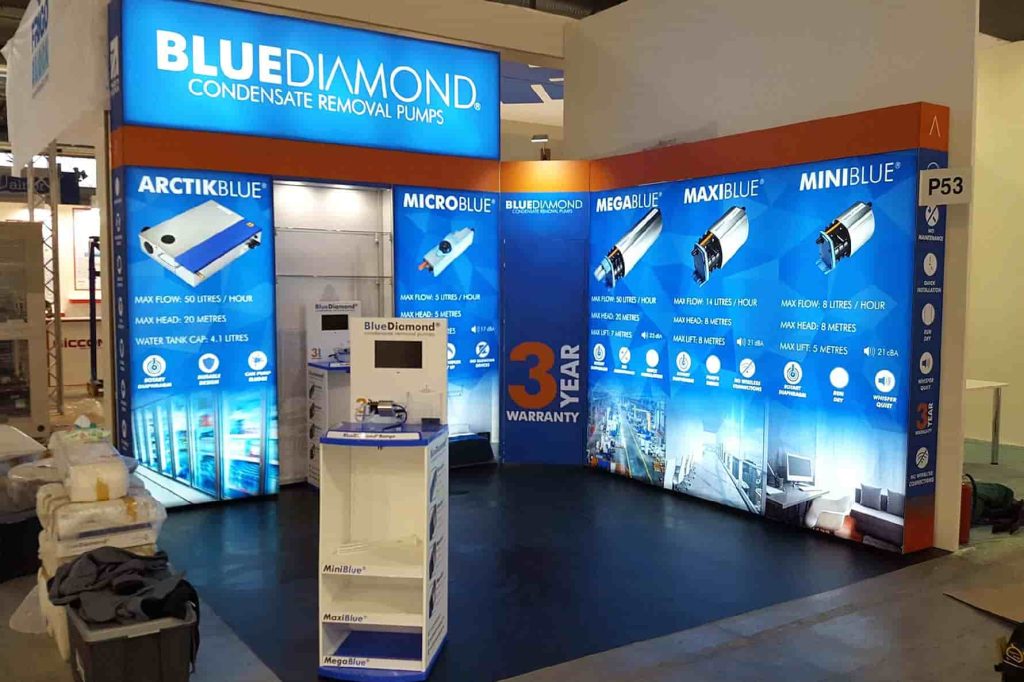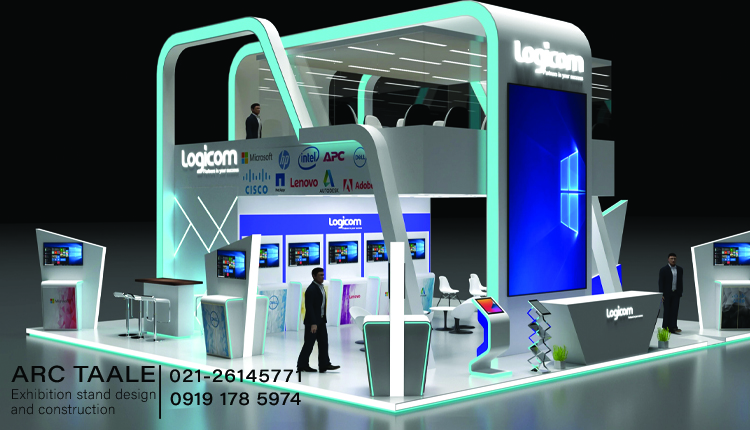In the world of exhibitions and trade shows, success isn’t solely determined by the visual appeal of your stand or the quality of your products—it’s also deeply influenced by the psychological and emotional impact your exhibit has on attendees. Understanding the intricacies of human Psychology in Exhibition Stand design can be the key to creating exhibition stands that leave a lasting impression and drive meaningful engagement. In this article, we explore how exhibitors can leverage psychological principles and emotional triggers to design stands that resonate with visitors on a deeper level, fostering connections and driving results.
Impact of Color Psychology in Exhibition Stand design
Color is a powerful tool that can influence emotions, perceptions, and behaviors, making it a crucial element in the design of exhibition stands. Understanding the principles of color psychology allows exhibitors to create immersive experiences that resonate with attendees on a deeper level, driving engagement and leaving a lasting impression.
Setting the Stage
In the intricate world of exhibition construction, the influence of color Psychology in Exhibition Stand design emerges as a captivating force, shaping the narrative, mood, and overall impact of the showcased content. From vibrant hues that evoke excitement to serene tones that invite contemplation, the palette chosen for an exhibition sets the stage for an immersive and memorable experience.
Beyond Aesthetics
Colors have the remarkable ability to communicate emotions and evoke specific responses. Warm tones like reds and oranges stimulate energy and passion, creating a sense of urgency and excitement. On the other hand, cool tones such as blues and greens induce calmness and tranquility, encouraging a reflective and focused atmosphere. The careful selection of colors becomes a language that transcends words, communicating the intended emotions to the audience.
Navigating Narratives
In exhibition construction, each section tells a unique story, and color plays a pivotal role in guiding visitors through these narratives. The strategic use of color helps in defining thematic zones, directing attention, and establishing visual hierarchies. Whether transitioning from one concept to another or creating a cohesive journey, color becomes the invisible storyteller, guiding the audience seamlessly through the exhibition space.
Cultural Connections
Colors hold cultural significance, and their meanings can vary across different societies. Exhibition designers delve into the depths of color symbolism, ensuring that the chosen palette resonates with the cultural context of the content on display. Whether it’s the auspicious red in Asian cultures or the regal purple in Western societies, understanding color symbolism fosters a deeper connection between the audience and the exhibited material.
read more
The Impact on Engagement
Beyond aesthetics, color Psychology in Exhibition Stand design significantly influences visitor engagement and memory retention. Studies indicate that certain colors can enhance information retention, making the exhibition content more memorable. By strategically incorporating color elements, exhibition designers can leave a lasting impression, ensuring that visitors carry the essence of the exhibition with them long after they leave the physical space.
Intricacies of Exhibition Stand Design Psychology
In conclusion, the psychology of exhibition stand design is a sophisticated interplay of art and science, where every element serves a purpose in influencing the thoughts, emotions, and actions of visitors. From the strategic layout that guides exploration to the nuanced use of colors, lighting, and interactive elements, designers wield the tools of psychology to craft stands that go beyond visual appeal, creating immersive and memorable experiences that resonate with a diverse audience.
The Psychology Behind the Design
In the realm of exhibitions, the Psychology in Exhibition Stand design transcends mere aesthetics, delving into the intricate science of human behavior and perception. Every element, from layout to color scheme, is meticulously crafted to elicit specific emotional responses, captivate attention, and foster meaningful connections between visitors and the showcased content.
Entrancing Entryways
The entrance to an exhibition stand serves as the initial encounter between the visitor and the brand or content being presented. Stand designers leverage principles of psychology to create visually compelling entryways, strategically using lighting, signage, and spatial design to captivate attention and entice visitors to explore further. The goal is to make a lasting first impression that sets the tone for the entire exhibition experience.
Navigating Flow
The layout of an exhibition stand is a carefully orchestrated dance, choreographed to guide visitors through a curated journey. Psychologically optimized pathways encourage natural flow, minimizing congestion and ensuring that visitors encounter key elements in a logical sequence. Whether using open spaces for communal interaction or creating intimate corners for focused engagement, the design seeks to enhance the overall visitor experience.
Beyond Sight
The Psychology in Exhibition Stand design extends beyond visual appeal, embracing multi-sensory experiences. Incorporating elements like ambient sounds, subtle fragrances, or tactile surfaces, designers aim to engage visitors on a deeper level. By stimulating multiple senses, the stand creates a memorable and immersive encounter that resonates with visitors long after they’ve left the physical space.
Color Palette Dynamics
Colors wield immense influence on emotions and perceptions. Exhibition stand designers strategically select color palettes that align with the brand identity and evoke specific feelings. Whether it’s the warmth of earthy tones to convey approachability or the sophistication of muted hues to communicate professionalism, each color choice plays a role in shaping the psychological response of visitors.
Psychology of Branding
Exhibition stands serve as tangible representations of brands, and their Psychology in Exhibition Stand design is deeply intertwined with building trust and recognition. Consistent branding elements, from logos to messaging, instill a sense of familiarity and reliability. Through strategic placement and repetition, designers aim to imprint the brand image on the minds of visitors, fostering a connection that extends beyond the exhibition floor.
Some psychological tips to attract people to the booth
the art of attracting people to a booth at a trade show involves a nuanced understanding of human psychology. By incorporating visually striking elements, open layouts, personalized touches, and leveraging psychological triggers like social proof and scarcity, exhibitors can create booths that not only draw attention but also forge meaningful connections with attendees, ultimately translating attraction into valuable engagement and leads.
Understanding the Mindset
In the dynamic realm of trade shows, understanding the psychology of attendees is a key factor in designing booths that attract and engage visitors. The art of attraction begins with grasping the mindset of potential leads, acknowledging their needs, preferences, and the factors that captivate their attention.
Capturing Attention
First impressions matter, and in the bustling atmosphere of a trade show, visual stimuli can be a game-changer. Employing bold and eye-catching graphics, signage, and displays instantly grabs attention. The Psychology in Exhibition Stand design behind this approach lies in the principle that a visually appealing booth acts as a magnet, drawing attendees in with the promise of intriguing content.
Inviting Openness
The physical layout of a booth plays a crucial role in influencing visitor behavior. An open and inviting space fosters a sense of approachability, encouraging attendees to step inside. By avoiding barriers or closed-off areas, the psychology of an open layout communicates accessibility and welcomes engagement, making visitors feel more comfortable exploring the offerings.
Creating Focal Points
Psychological research suggests that humans are naturally drawn to focal points. Designing a booth with strategically placed focal elements, such as interactive displays, demonstrations, or prominent branding, guides the gaze of attendees. By creating visual anchors, the booth ensures that visitors are not only attracted but also directed towards key messages and offerings.
Personalization and Connection
A personalized approach resonates deeply with individuals. Booths that incorporate elements catering to specific interests or preferences of the target audience tap into the psychology of connection. Whether through tailored content, interactive experiences, or customized giveaways, personalization establishes a sense of relevance, making attendees more likely to engage with the booth.


